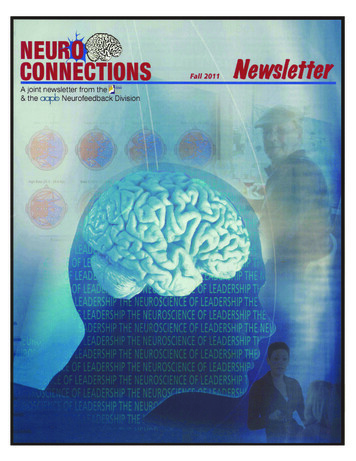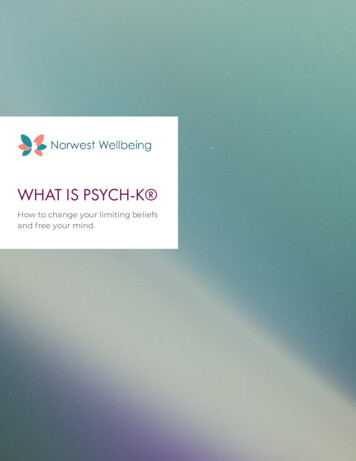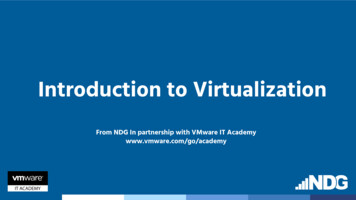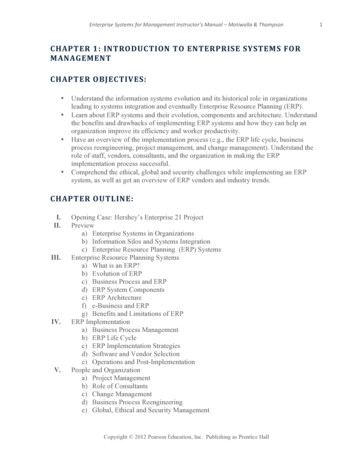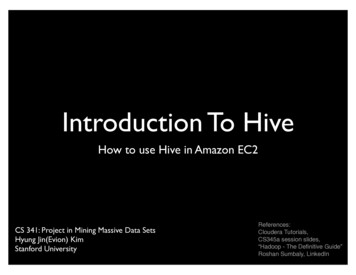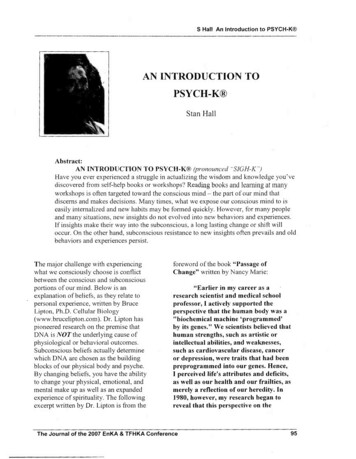
Transcription
S Hall An Introduction to PSYCH-K AN INTRODUCTION TOPSYCH-K Stan HallAbstract:AN INTRODUCTION TO PSYCH-K (pronounced ··SlGH-K 'JHave you ever experienced a struggle in actualizing the wisdom and knowledge you'vediscovered from self-help books or workshops? Reading books and learning at manyworkshops is often targeted toward the conscious mind - the part of our mind thatdiscerns and makes decisions. Many times, what we expose our conscious mind to iseasily internalized and new habits may be formed quickly. However, for many peopleand many situations, new insights do not evolved into new behaviors and experiences.If insights make their way into the subconscious, a long lasting change or shift willoccur. On the other hand, subconscious resistance to new insights often prevails and oldbehaviors and experiences persist.The major challenge with experiencingwhat we consciously choose is conflictbetween the conscious and subconsciousportions of our mind. Below is anexplanation of beliefs, as they relate topersonal experience, written by BruceLipton, Ph.D. Cellular Biology(www.brucelipton.com). Dr. Lipton haspioneered research on the. premise thatDNA is NOT the underlying cause ofphysiological or behavioral outcomes.Subconscious beliefs actually determinewhich DNA are chosen as the buildingblocks of our physical body and psyche.By changing beliefs, you have the abilityto change your physical, emotional, andmental make up as well as an expandedexperience of spirituality. The followingexcerpt written by Dr. Lipton is from theforeword of the book" Passage ofChange" written by Nancy Marie:"Earlier in my career as aresearch scientist and medical schoolprofessor, I actively supported theperspective that the human body was a"biochemical machine 'programmed'by its genes." We scientists believed thathuman strengths, such as artistic orintellectual abilities, and weaknesses,such as cardiovascular disease, canceror depression, were traits that had beenpreprogrammed into our genes. Hence,I perceived life's attributes and deficits,as well as our health and our frailties, asmerely a reflection of our heredity. In1980, however, my research began toreveal that this perspective on theThe Journal of the 2007 EnKA & TFHKA Conference95
S Hall An Introductionto PSYCH-K nature of life was flawed. By 1985 Irealized that rather than beingcontrolled by our genes, our cells arecontrolled by their perception of theenvironment. I formulated a hypothesisthat the "brain" of the cell was actuallythe cell membrane, and I was offered anopportunity to test this hypothesis as aresearch fellow at Stanford University'sSchool of Medicine in 1987. My theoryon the control of our cells by ourperceptions was substantiated in twomajor scientific publications. Thispioneering research presaged one oftoday's most active areas ofinvestigation: epigenetics, the science ofhow genes are controlled by theenvironment and-more importantly-byour perception of that environment.This new perspective on human biologydoes not view the body as just amechanical device, but incorporates therole of mind and spirit. Thisbreakthrough in the science of biology isfundamental to healing, for it shows usthat when we change our perceptions orbeliefs we send totally differentmessages to our cells. In effect, wereprogram them. This new biologyreveals why people can havespontaneous remissions or recover frominjuries thought to be permanent. Thebody really represents the cooperativeeffort of a community of fifty trillionsingle cells. While every cell is anindependent entity, the body'scommunity accommodates the wishesand intents of its "central voice" -themind and spirit. Our principle source ofstress is our mind, which really consistsof two separate "minds"-the consciousand the subconscious. The consciousmind is the thinking "you." It is thecreative mind that expresses free will.Its supporting partner is thesubconscious mind, a database of96programmed behaviors. Some"programs" are derived from genetics.However, the vast majority of oursubconscious programs are acquiredthrough the developmental learningexperiences we have as children. Thesubconscious mind is not the seat ofreasoning or creative consciousness. It isstrictly a stimulus-response device.When the subconscious mind perceivesa signal from its environment, itreflexively responds by activating apreviously stored behavioral response no thinking required! Our fundamentalperceptions or beliefs about life weredownloaded into our subconscious mindas we simply observed the behaviorsand attitudes of our parents, siblingsand peers during the first six years ofour lives. Our adult mind's effectivenessnow is defined by the quality of theprograms carried in our subconsciousmind. The insidious part is that oursubconscious behaviors areprogrammed to engage without thecontrol of, or observation by, theconscious self. Since most of ourbehaviors are under the control of thesubconscious mind, we rarely observethem, much less know that they areeven engaged."In alignment with Dr. Lipton's researchand findings, PSYCH-K is founded on theprecept that subconscious beliefs are whattruly determine the quality of all our lifeexperiences.BELIEFSBeliefs can be understood as filters and inmany cases, limitations. When we witnessan incident or are involved in a situation,all of our senses pick up an enormousamount of information. The consciousmind, due to its limited processingcapacity, could not possibly process such aThe Journal of the 2007 EnKA & TFHKA Conference
-------S Hall An Introduction to PSYCH-K .-- . -- . -----------------vast amount of information. Processing allof this information is the roll of thesubconscious, in turn, keeping ourconscious mind stabilized and out ofoverwhelm as much as possible. Ourbeliefs, or filters, determine whatinformation is pertinent and what is not. Avast majority of the information is filteredout and deleted as irrelevant. The pertinentinformation (according to our currentbeliefs/filters) is assigned meaning orvalue, which in turn creates perception.From the perception, the subconscious, asmuch as possible, searches its data bankfor a similar situation experienced in thepast to determine what actions, orreactions, are necessary. This signal is fedback to the brain for execution in thephysical body, ultimately producing atendency or compulsion of emotion orphysical behavior. The tendencies orcompulsions are either carried out, often asa habit, or overridden by the consciousmind.Subconscious beliefs determine the qualityof our lives as a whole by determining thequality of our individual experiences.FLOW OF HUMAN EXPERIENCEOutside Stimulus/Information(environmental signals, situations).Subconscious mind detectsstimulus/information.Subconscious deletes, distorts, andinterprets information according to beliefs(filters) and determines meaning and value(perceptions).Subconscious sends response (or reaction),according to perceptions, to the brain .Brain sends messages chemically andelectrically to the body for action(emotional or physical response).Experience - Conscious Mind justifiesSubconscious reaction,Or. . makes adjustment and overridesreaction.CONSCIOUS VS. SUBCONSCIOUSThe conscious portion of our mindobserves and witnesses what we actuallyexperience: the result of filteredinformation from the environment. This iswhat most of us would call our workingreality. A helpful metaphor for theconscious mind is the desktop that you seeon the monitor of a computer. All you seeis the document with little to no awarenessof the programming that makes theapplication of the document work.The subconscious portion of our mind iswhat runs everything behind the scenes.Comparatively to the computer, it is allprogramming and flies stored on the harddrive that runs the computer itself and theapplications. Below is an metaphoricalcomparison between human and computer:HLJMANCOMPUTERConscious mindDesktop (what is observable on themonitor)Subconscious mindSoftware (operating system, officesoftware)Physical bodyHardware (CPU, keyboard, monitor, etc.)Feelings/emotionsApplications and DocumentsThe conscious and subconscious mindsplay very different and important roles .The following are a few definitivecharacteristics of each role:THE CONSCIOUS:THE SUBCONSCIOUS::JThe Journal of the 2007 EnKA & TFHKA ConferenceShort term memory (about 25 seconds)97
5 Hall An Introductionto PSYCH-K WHY LASTING CHANGES CAN BEDIFFICULT TO ACHIEVE -:: Long tenn/Pennanent memory':.' Contemplates changes, justifies actions,creates goals and intention, discerns.Operates according to programming: '(Physiological, mental & emotionfunctions)C- Entertains new ideas, new information Supports status quo, resists change ' Comprehends figuratively & abstractly::.3 Comprehends literally & through senses:J Operates mostly in past or future mode[ Operates only in the presentr::J Very limited processing capacity(40 bits per second)r :' Expanded processing capacity(40.000,000 bits per second)CONSCIOUS FREE WILL CHOICEEach day we make hundreds if notthousands of free will choices. Habits areforms of free will choices - evenperceivably destructive ones. However,understanding how choices are limited inavailability by subconscious beliefs iscrucial to self-forgiveness, acceptance,healing, and growth. Dr. Lipton presentsthat much of our belief system isdeveloped before the age of 6 (i.e. beforewe have developed conscious discernmentregarding what is truly best for us). Thesebeliefs often delete information from ourenvironment that would otherwise providemore options with which to respond.Additional options outside of what weperceive are always available. However,our subconscious beliefs/filters often blindus to them, or attach such a meaning that itfeels natural or very compelling to chooseeven a destructive option.Changing subconscious beliefs and filtersin a particular manner automaticallyallows an expanded number of optionsinto your awareness, providing choicesthat are beneficial, abundant, healthy,harmonious, loving, and more.98 A full commitment to the change must beconsidered. Components such as time andresources necessary to allocate to a newexperience are part of this. Any change inone aspect of life often affects all others.Relationships may also change as anoutcome of changing any part of you.Reviewing the possible outcomes of beliefchange is an important part of determiningwhat you really would like to create in life. Clarifying your desired experience inliteral and specific terms is crucial. Theconscious mind thinks figuratively andabstractly while the subconsciousinterprets literally and through the senses.Any desired experience must becommunicated to the subconscious in alanguage it understands. By nature, the subconscious is resistantto change. The subconscious' idea of"doing a good job" is to hold the currentset of beliefs as a strategy for survival orsuccess in the world. An importantcomponent of changing beliefs is reducingor removing that resistance in somefashion.If we could take all of the wisdom we haveconsciously digested from all the bookswe've read and workshops attended andactually installed them into thesubconscious in the form of beliefs, wewould be the gurus we read about.PSYCH-K bridges the canyon betweenknowing and being or doing.WHAT IS PSYCH-K?PSYCH-K is a self-empowered processthat transforms limiting subconsciousbeliefs into life supporting and successpromoting experiences. Whether you'veread a shelf full of self-help books or not,YOU are the expert on YOU! PSYCH-Krecognizes this and includes accessing theexpert within you for guidance.The Journal of the 2007 EnKA & TFHKA Conference
S Hall An Introduction to PSYCH-K - .,-------- . ------- .Rob Williams, MA developed PSYCH-Kin 1988. It is a culmination and distillationof numerous fields of study includingEducational Kinesiology, NeuroLinguistic Programming (NLP),acupressure, hypnotherapy and variousother psycho-spiritual healing systems.Developed to be easy to learn and use,virtually anyone who is willing can learnhow to use the tools in a two-dayworkshop and apply them immediately.Mr. Williams' book, "The Missing PiecePeace In Your Life," offers a moredetailed description of how the processcame about and how you can use it tosignificantly enhance or improve your life.PSYCH-K is based on the foundation thatsubconscious beliefs determine ourattitudes and experiences. They determinehow we are in relationships, how we reactto situations, and they also affect ourphysical health.Subconscious beliefs are changed withprotocols called "balances." These aretechniques that are designed to create abalanced identification with bothhemispheres of the brain called a "wholebrain" state. This state is ideal for reducingor eliminating resistance at thesubconscious level allowing earlierprogramming to be overwritten byconsciously chosen ways of being.True creativity actually occurs when bothsides of the brain are working incollaboration: the "whole brain" state. ThePSYCH-K Basic Workshop provides anexpanded explanation of the Left/Rightbrain concepts and characteristics typicallyassociated with each side of the brain.Practically speaking, it is only important tounderstand that there is a tendency forcertain personal situations to be overidentified with one side of the brain or theother. A more important perspective is thatthese situations are associated with only alimited amount of resources and options.PSYCH-K provides the means to achievea high level of collaboration within thebrain to make all resources available forany given situation. In turn, expandingoptions available, with which to respond inany situation.Included in the process is a pennissionprotocol: a way to consult your "ExpertWithin" to find out if a particular changeis in your best interest. This protocol setsPSYCH-K aside from many othermodalities of healing or change, includingmedical treatments. Many modalitiessimply assume a remedy of
AN INTRODUCTION TO PSYCH-K (pronounced ··SlGH-K 'J Have you ever experienced a struggle in actualizing the wisdom and knowledge you've discovered from self-help books or workshops? Reading books and learning at many workshops is often targeted toward the conscious mind - the part of our mind that discerns and makes decisions. Many times, what we expose our conscious mind to is easily .

